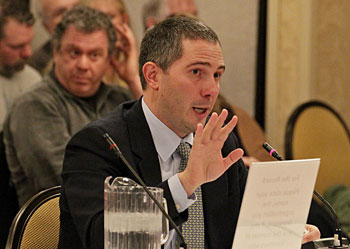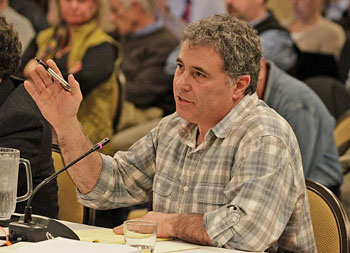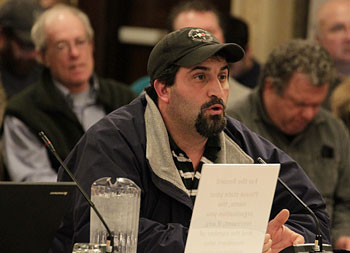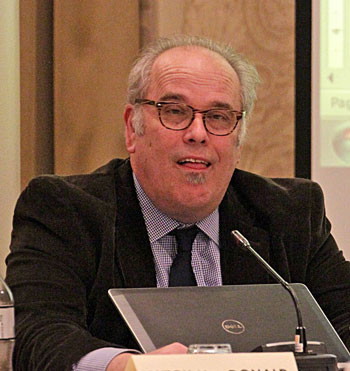WAKE OF THE SACRED COD?
continued from Home Page

Science & Statistical Committee Chairman Jake Kritzer. “Scientists are not yet able to link any environmental indicators with stock attributes. But because we have two lines of evidence, one from biology of the stocks and one from environment, it suggests perhaps that one is driving the other and we should look into that and figure that out.”©Photo by Sam Murfitt
The cuts came on the heels of the latest cod assessments, conducted in December, which updated information received a year previously that indicated both Gulf of Maine and Georges Bank cod were in poor condition.
According to the assessment summary on Gulf of Maine cod, the fall 2011 and spring 2012 survey abundance indices were lowest in their respective time series for the stocks.
Regarding Georges Bank cod, the report said, “The last above average year class was 1991. Until spawning stock biomass gets above about 50,000 [metric tons], recruitment is likely to remain low and rebuilding will be slow.”
For Gulf of Maine cod, for the fishing years 2013-2015, the NEFMC considered two catch alternatives, called the “acceptable biological catch” (ABC) – 1,249 mt or 1,550 mt, both substantially lower than the 6,700-mt ABC for 2012. According to the NEFMC’s Scientific and Statistical Committee (SSC), the 1,550-mt figure had a slightly higher risk of overfishing, but was willing to put it forward.
Northeast Fisheries Science Center (NEFSC) scientist James Weinberg told the NEFMC that “retrospective patterns” in previous assessments have led to management advice that was too liberal. The term “retrospective pattern” means the assessment tends to overestimate stock size and underestimate fishing mortality.
“One approach is have more buffer, so for the next year, adjustments can be made, and catches can be closer to what you intend it to be,” said Weinberg. “That doesn’t make the model any better, but it could be a solution.”
The January actions were the latest over the course of a year, when scientists and managers were wrestling with the question of what went wrong with plans to rebuild cod stocks.
In 2008, fishery scientists judged that the Gulf of Maine cod stock was doing pretty well. Like many groundfish stocks throughout the Northeast, the Gulf of Maine cod stock had been severely depleted due to overfishing. In the 1990s, federal law drove a new management regime designed to protect groundfish and boost their numbers to sustainable levels. The deadline for rebuilding Gulf of Maine cod was 2014. According to a stock assessment published in 2008, it appeared the stock was well on target and could support continued fishing. The assessment indicated that, by 2007, the stock had reached 58 percent of the biomass target. And indications were that a large recruitment was coming in, which scientists expected could further help to rebuild the stock.
But a year ago, in January 2012, Weinberg told the NEFMC the 2008 assessment turned out to be faulty. An updated assessment had just been completed, Weinberg said at the time, and it revealed that the stock continued to be overfished. Even if fishing were immediately to halt, the stock would not be rebuilt by 2014.
At the time, fishery managers scrambled to find ways to avoid a complete shutdown of the GOM cod fishery. This stock is considered a “choke” species – when fishing is halted on a choke species, fishermen who harvest other species must also stop fishing if their gear type is capable of catching the choke species.
In September 2012, the U.S. Department of Commerce declared a commercial fishery failure in the Northeast groundfish fishery for the 2013 fishing season. But Congress has failed to appropriate disaster funds to alleviate the industry’s financial hardship.
Regime Shift
In January, NEFSC scientists updated NEFMC on the challenges of working out projections in the dynamic marine environment. For one thing, they said, new ecosystem patterns – which they called a “regime shift” – may be affecting fish populations.
“There’s evidence out there that regime shifts may be underway,” said SSC chairman Jake Kritzer. Kritzer said that changes in fish populations “suggest we may be operating in a different environmental state. We did not make conclusions; we raise it as a hypothesis.”
Kritzer said the SSC is always uneasy about developing catch advice three years out, given the uncertainty of projections that far ahead. The further out one goes, Kritzer said, the more scientists end up relying on assumptions rather than empirical evidence.
Regarding cod in particular, Kritzer said that, in developing its advice to the NEFMC, the SSC had “very little confidence in projected biomass three years out. When you overlay projections from earlier assessments on the biomass, there’s a big gap between them. So we’re setting overfishing limits based on biomass estimates that we don’t have a lot of confidence in….Some improvements have been made, but there’s still tremendous uncertainty.”
Kritzer continued, “The question of whether we’re seeing regime shift comes from two directions” – indications of change in specific stock attributes; and studies – of freshwater inflow, patterns in plankton distribution, patterns in temperature and salinity, for example – that indicate the Gulf of Maine ecosystem itself may be changing. Changes on both scores appear to be “directional” and not just “random noise,” Kritzer said.
Scientists are not yet able to link any environmental indicators with stock attributes, he said. “But because we have two lines of evidence, one from biology of the stocks and one from environment, it suggests perhaps that one is driving the other and we should look into that and figure that out.”

Vito Giacalone, Gloucester fisherman, chairman of governmental affairs Northeast Seafood Coalition. “It adds up to a 90 percent reduction total. Given the failure of the original 10-year rebuilding programs, the fleet has “no faith” in the current projections. I don’t understand why we accept 10-year rebuilding plans with risky projections. We’re on the heels of a disaster.” ©Photo by Sam Murfitt
Kritzer said that actual catches have been fairly consistently below the catch limits, “and there are a variety of reasons that could be the case. It doesn’t necessarily mean there are fewer fish out there. It could be there are shifting distributions of fish that make them harder to find. But one possibility is that we’re overestimating the number of fish that are actually out there. We’ve seen some slow recovery, but it hasn’t been…as rapid as what we were hoping for.” Other metrics, such as truncation of the age structure, support these findings, Kritzer said.
“A variety of indicators that fed into the assessment suggest the stock is in bad shape,” he said.
John Bullard, NMFS’ northeast regional administrator, said that, in the meantime, NEFMC must face the possibility that the stocks may never be rebuilt.
“It seems to me we have to acknowledge the possibility that these stocks are so low, and the stocks have so fundamentally shifted in terms of relative balance between predator and prey and other environmental factors, that there certainly is the chance that we might get to a condition where you could stop all fishing and they would not rebuild,” Bullard said.
“Look at the levels of recruitment that are persistently low and look at the history in Canada, where all fishing stopped and stocks did not rebuild. We have to recognize that that is at least a possibility. That is what we’re facing. This is a serious situation. All of us have talked about how, with regime shift, we’re not aware of all the forces that are at work out there now, and we need to learn a lot more about that. But certainly the possibility exists that…we might make all of these difficult decisions that are in front of us, and it might not be enough. I hope it’s not the case, but that is certainly a possibility.”
A year ago, said Bullard, when NEFMC took the “extraordinary” action that granted an interim measure of setting a higher quota, “we all were very hopeful that the stock assessment was wrong, that the fleet would find more fish, that the stock assessment would find more fish. And all of that proved to be wrong. The fleet didn’t find any more fish and neither did the stock assessment. So now we listen to the science and we have the decisions before us.” Bullard said he did not have the legal basis to allow a second year of interim action.
The consensus among fishermen was that the cuts would mean the collapse of the industry. New Hampshire fisherman David Goethel said that revenues projected by economists, once the cuts were in place, were far too optimistic.
Examples of projected groundfish catches and revenues for 2013, for selected states are: Maine – from $17.2 million and 17 million pounds in 2012 to $12.7 million and 13 million pound in 2013; Massachusetts – from $52.7 million and 37.7 million pounds in 2012 to $33.4 million and 26.8 million pounds in 2013; and New Hampshire – from $5.2 million and 4 million pounds in 2012 to $2.8 million and 2.8 million pounds in 2013.
“The infrastructure is going to collapse,” said Goethel. “You won’t have enough fish to keep cutting lines going. That will lead to lower ex-vessel prices. So I don’t buy into any of this….I think we should make it clear here that our economists do the best they can, but the reality is that it’s fantasy. I’d rather go to Disney World. I’ve got a better chance of meeting Peter Pan….I know what’s going to come into New Hampshire next year, and the answer is, virtually nothing.”
NEFSC director Bill Karp read a communication just received from NEFSC’s social sciences branch, penned by economist Chad Demarest. “They have concerns relative to deficiencies in this analysis,” Karp said. The communication said that groundfish businesses in New England have undergone a “tumultuous three years” under sector management, and that drastically reduced quotas will affect profitability over the coming year. The missive said the economic impact analysis for Framework 50 doesn’t adequately address the impacts. In the note, the branch said it has undertaken an in-depth study of vessel-level impact, incorporating sector member-level data and monitoring costs, including new observer costs in 2013. The missive committed to publishing the new analysis in time for NEFMC’s June meeting.
Joe Orlando, a Gloucester fisherman and president of Sector 2, said that, with the accumulation of cuts, “I don’t see myself even at the dock this year. This year, I’ll probably only take one trip, compared with 20 or 30 trips. It adds up to a 90 percent reduction total.”
Vito Giacalone, chairman of governmental affairs with the Northeast Seafood Coalition, said that, given the failure of the original 10-year rebuilding programs, the fleet has “no faith” in the current projections.
“I don’t understand why we accept 10-year rebuilding plans with risky projections,” Giacalone said. “We’re on the heels of a disaster.” With no disaster assistance coming, 50 percent of monitoring costs being laid on the industry, and quota taken off the table, it’s “game over for just about everybody,” he said.
Fishermen who were able to make the shift to a sector-based quota fishery, under Amendment 16, thought they would have some business stability, Giacalone said.
“Now the bucket has totally fallen out,” he said. “We’re out of answers.”

Gloucester fisherman Paul Vitale, NEFMC meeting, Portsmouth, N.H. “Year after year we get punished. We have done everything that’s been asked of us. We have put forward proposals, many of which have been rejected. We’re looking at total, complete loss of everything. Then it will hit the port, the docks, the supports. We said this is going to be a disaster; nobody listened to us.©Photo by Sam Murfitt
“Year after year we get punished,” said Gloucester fisherman Paul Vitale. “We have done everything that’s been asked of us. We have put forward proposals, many of which have been rejected. It’s never good enough. I’m sick and tired of this crap. If you just give us a little bit of fish, nobody’s going to be able to buy or sell quota. We’re screwed. We’re looking at total, complete loss of everything. Then it will hit the port, the docks, the supports. It will shut down everybody – commercial, rec, charter/party. This is getting freaking ridiculous, the pain we go through trying to rebuild this stock. We get sectors shoved down our throat. We said this is going to be a disaster; nobody listened to us. This is an outrage. We need to be protected, for once.”
“We’ve done everything you asked us to do,” said Port Judith, R.I., fisherman Brian Loftus. “We’ve lost our fleet by almost 60 percent. What leg do you have to stand on to regulate this business one more day? We shut down the fishery and we shit-can everybody who works for NMFS, we use that money to help everyone in the industry. You have no business managing this fishery one more day.”
Tina Jackson, president of the Wakefield, R.I.-based American Alliance of Fishermen and their Communities, questioned the ability of fishery scientists to be able to discern the quality of the science they produce.
“For years, you’ve been talking about how bad [the science] is, that it’s never been rectified, yet you cut, cut, cut,” Jackson said.
Jackson told NEFMC that she had submitted a Freedom of Information Act (FOIA) request for documents pertaining to trawl surveys performed on the research vessels Henry Bigelow, Pisces and Albatross, including copies of the handwritten captains’ ship logs and handwritten documentation recorded by the SSC for specific years.
In her remarks to NEFMC, Jackson said she noticed “quite a few discrepancies” between each ship’s chart of sampling stops and the progress of each ship as shown via NOAA’s ship tracker.
The FOIA request says, “If the current cutbacks are allowed to occur the entire Northeast ground fishing industry will certainly be eliminated and I feel that stock assessments are so important that the release of this information will further public understanding of how stock assessments are made. The loss of jobs and revenue to all current permit holders, concerned states and the loss of revenue throughout the country are of the utmost importance and this request may pave the way for considerations other than restrictions through any of the Regional Fisheries Councils.”
“It’s midnight and it’s getting darker,” said Erik Anderson, president of the New Hampshire Commercial Fishermen’s Association, “What a mess. We’re here again,” said Richard Canastra of North Dartmouth, Mass., a member of the NEFMC’s groundfish advisory panel. Canastra suggested the millions of lobster traps, from Cape Cod to Maine, may be a culprit in the loss of codfish.
“Has anyone looked at that?” Canastra asked.
Canastra continued, “We’re supposed to have confidence in the science and in the economic analysis. These men and women in this industry will be going out of business.”
For the New Hampshire fleet, Canastra said, “This is the last straw that’s going to break the camel’s back.”
“The decision you have to make today, it’s not your fault, ladies and gentleman,” Canastra said. “My advice to you is to have a vote of no-confidence in the science, in the economic analysis, and start again.”
Ellen Goethel, a marine biologist who is on the board of directors for Sectors 11 and 12 in New Hampshire, called for the NEFMC to commission a new socio-economic impacts study. “If you’re allocated fish to fish three days, then you don’t have a viable business,” Goethel said. “At what point does that business reach the point of no return, where it won’t leave the dock? Without that analysis, you don’t know what’s really going on in New England.
As far as New Hampshire is concerned, there will be no viable businesses. There’s just barely any viable businesses as we speak. But with the type of cuts we’re talking about, it won’t be worthwhile for the fishermen to leave the dock. Which means there is a huge economic depression going on in New Hampshire, and for the small vessels in New England. There are stocks that haven’t been caught. It’s not because the stocks aren’t there. It’s because the fishermen are fishing in a different way.”
Goethel said that forcing fishermen to pay 50 percent of at-sea monitoring cost was horrifying. “It’s like adding insult to injury,” Goethel said. “It’s just absolutely amazing that you came up with this. I think NMFS can find the money to pay for this. If you need that level of observers, then you need to find the money to pay for it, rather than sticking it on our backs.”

Gene Martin, NOAA since 1995 General Counsel. During the last NEFMC meeting David Pierce asked for verification of the reference points used to set quota. Martin’s response is illustrative of the bureaucratic barriers fishermen face in NEFMC management proceedings. To listen, go to: fishermensvoice.com for a link. Martin’s response follows Pierce and Doug Grout just beyond the center of the audio for Wed. 1/30/13 tape #7. ©Photo by Sam Murfitt
Jim Kendall, executive director of New Bedford Seafood Consulting, told NEFMC that fishermen are not at fault. They’ve been provided with quotas for each stock, and have not overfished the quotas, he said. Kendall said the fault lies with faulty science, which leads to poor management.
“But who’s being asked to make the payment once again?” Kendall continued. “The bill is being sent to the door of the fishermen. Those doors aren’t going to be standing much longer. If the science is no good, you’re not going to twist and turn it. You’re not going to do anything with it except rationalize the fact that it’s not as good as it needs to be to take the steps that are mandatory to be taken. At some point, you’re going to have to say no-confidence. If we know this, then we need to fix it, not turn around and say, ‘We have to make a decision before we fix it.’ We need to fix the science to protect not only the stocks, which people depend on. This isn’t something people want to throw away. They need it today and tomorrow for their kids. If Magnuson is the law of the land as far as the fisheries go, there’s got to be room in there to say the science is bad and it needs to be fixed….I ask you to find a way to take a vote of no-confidence. I’m not blaming the scientists. But the process has gone wrong and we’ve allowed it to keep going and at some point it has to stop.”
But Peter Shelley, senior counsel with the Conservation Law Foundation, warned, “There’s no biological wriggle room left. This is your best available science, and this is what your motions have to be based on. There’s a history of consistently overestimating the biomass and underestimating the fishing in the real world.
Jobs and infrastructure are going to be lost. That’s a terrible result. But a far worse result would be failing to take action that would secure a possibility for a future for this fishery. This council has never been precautionary. The council has always leaned toward short-term economic and social interest over the long-term fishery interest.”
The scope of the problem, said Shelley, has expanded from groundfish overfishing to “ecosystem overfishing.”
“We have been pushing this system beyond its ability to reproduce for many, many decades,” Shelley said. “Except for a few fisheries, like scallops – and most of the management for scallops has been from the industry itself, not the council – many fisheries are at risk because of the council’s failure to manage for the long-term.”
Shelley said the cod quotas will only drive the risks up higher.
“We have a failure of science, said fisherman Frank Marachi of Scituate, Mass. “Today we’re facing industrywide economic collapse and the scientific establishment is struggling to find answers. We need to do something big and we need to do it fast.”
Marachi proposed that Congress should fund cooperative research that would aim for an understanding of the shifting ecosystem, in order to help inform stock assessments. “We’re no longer dealing with a static ecosystem,” Marachi said, citing such indicators as geographic and seasonal shifts in species. “It means we don’t know enough at present to characterize stocks several years in advance.”
